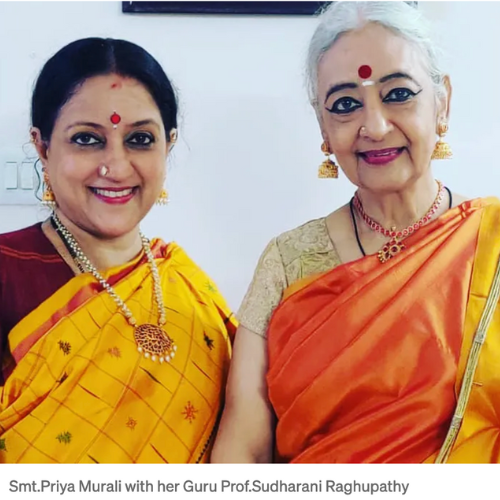Guided by Grace: Priya Murali on Her Guru, Prof. Sudharani Raghupathy
- Nirvikalpa
- Jul 20
- 3 min read
Updated: Jul 21

In the realm of darkness, where ignorance blinds the sight, there shines the radiant light of knowledge, applied like a soothing balm by the revered Guru. To that sacred guide who unveils the eyes of wisdom, I offer my humble salutations.
Describing the profound bond between my mentor, Sudha Aunty, and me is no simple task. Words falter, unable to encapsulate the depth of this relationship forged over five decades. It transcends time, rooted firmly in the karmic fabric of existence. Sudha Aunty, not only connected with my family since her days in Bengaluru but also became intricately linked with my life through marriage into a family close to her heart.
Upon encountering Sudha Aunty for the first time, her majestic presence left an indelible impression on me. With grace personified, she exuded a regal aura, her eyes radiating warmth as she affectionately addressed us as ‘darlings,’ making each of us feel cherished and valued. Under her tutelage, we delved into the intricacies of Bharatanatyam, embracing the nuances of the Thanjavur bani. Our journey extended beyond mere dance lessons; we immersed ourselves in storytelling, Sanskrit slokas, and discussions on musicality and Carnatic music.
Sudha Aunty fostered a holistic approach to learning, enriching our experiences with diverse subjects ranging from Indian philosophy to western existentialism, from the complexities of British royalty to the intricacies of fashion and costume design. Her influence permeated every aspect of our lives, shaping our perspectives and nurturing our growth.
From the tender age of six to my fifty-seventh year, I have been privileged to witness Sudha Aunty’s artistic journey, marked by a succession of milestones achieved through her consummate skill. Her belief in the transformative power of art echoes profoundly — “Art makes Man a Better Man.” Through her, I imbibed the essence of Natyam as a synthesis of body, mind, and soul — a conduit for conveying profound truths.
Sudha Aunty instilled in us a reverence for education and academic pursuit, recognizing its symbiotic relationship with the arts. She advocated for spontaneity in abhinaya, tempered by diligent study and immersion in our cultural heritage. Punctuality, practice, and perseverance were the cornerstones of her teachings, shaping us not just as dancers but as individuals committed to excellence.
Our learning journey encompassed a multitude of disciplines — from studying temple sculptures and Brahma Sutra to mastering Martha Graham technique and public speaking. Sudha Aunty’s insatiable thirst for knowledge fuelled our own intellectual curiosity, fostering a continuous exchange of ideas that transcends physical boundaries through modern means like WhatsApp. In gratitude, I acknowledge that I am who I am because of her unwavering guidance and mentorship. Sudha Aunty remains a beacon of inspiration,illuminating the path of self-discovery and artistic fulfilment for generations to come.
The Intertwine of Music and Dance:
From ancient rituals to modern-day performances, the interplay between music and dance has been a captivating force, enriching cultures, and inspiring creativity through the ages. For me, music is more than just a pastime; it’s the very essence of my being.
Growing up in an artistic family steeped in musical traditions, I was surrounded by a rich tapestry of sounds. Both of my brothers were instrumentalists, wielding their talents in a popular Western band that dominated the 1980s music scene. Meanwhile, my aunt enchanted audiences with her soul-stirring performances as a renowned Carnatic vocalist. Our home resonated with melodies spanning across genres — from the classical notes of Carnatic and Hindustani music to the rhythmic beats of Bhajans, Semi-Classical tunes, Film Music, and the electrifying rhythms of Jazz and Rock Pop. Music wasn’t just a background noise; it was the lifeblood that nourished our souls. But what is dance if not visual music? It’s the embodiment of melodies and rhythms, expressed through graceful movements and fluid gestures.
During my time at our Alma Mater, music wasn’t just a separate entity — it was intricately woven into our dance curriculum. We didn’t just learn choreography; we delved into the theory, mythology, and nuances of music. The Thanjavur bani, celebrated for its musicality, made Carnatic music an indispensable part of our education. We didn’t just dance to music; we became one with it.
Understanding the intricate rhythmic patterns, anticipating the subtle nuances of gamakas in a sahityam, music became the river that carried our movements and expressions. It provided the framework within which our creativity blossomed, allowing us to explore the depths of our emotions through dance. The spontaneous interplay between the notes and our bodies was a fascinating journey of discovery, where each movement echoed the melody and rhythm of the music.
In essence, our journey through music and dance wasn’t just about mastering techniques; it was about immersing ourselves in the timeless symphony of human expression, where every step and every note became a testament to our shared humanity and boundless creativity.




Comments